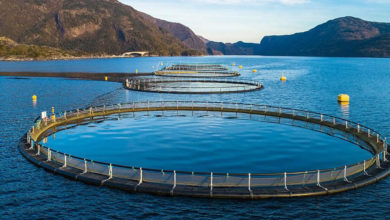The series on Sustainable Marine Aquaculture Article 3 – Expanding advanced models
In the coming years, Khanh Hoa aims to expand pilot models for marine aquaculture using advanced technology, increasing scale and pilot areas.
Expanding high-tech marine farming to 110 hectares
In the first phase (from now until the end of 2025), Khanh Hoa will extend its pilot high-tech marine farming model to a scale of 30 hectares, utilizing funding support from the Thien Tam Fund (Vingroup).

Building on the results of high-tech marine farming in open waters conducted by the Khanh Hoa Agricultural Extension Center in cooperation with the Thien Tam Fund in Cam Ranh City, involving 10 participating fishermen, the province will further expand the model. This includes transitioning 150 households from traditional cages to HDPE cages.
Specifically, the following areas will be developed:
- Van Ninh District: 2 hectares with 10 households.
- Ninh Hoa Town: 1 hectare with 5 households.
- Nha Trang City: 1 hectare with 5 households.
- Hon Noi Area: 10 hectares with 50 households from Cam Lam District and Cam Ranh City.
In the second phase (2026–2027), the high-tech marine farming model will expand to 100 hectares, involving 500 households transitioning to HDPE cages. The third phase (2028–2029) will further increase the scale to 110 hectares with 550 households adopting advanced cage systems.
Challenging but necessary
Nguyen Hai Ninh, former Secretary of Khanh Hoa Province and now Minister of Justice, emphasized:
“The farther offshore we go, the greater the risks and challenges in aquaculture. Pilot projects may succeed or fail, but without taking action, we’ll never achieve success.”
As Nguyen Hai Ninh envisioned, the pilot models have proven highly effective. For instance, Phan Van Thanh and Nguyen Van Cu from Cam Lap Commune, Cam Ranh City, were each supported with two 13-meter-diameter HDPE circular cages, each with a volume of 800 cubic meters and a value of 530 million VND, to raise cobia.
After just eight months, the cobia grew well, reaching weights of 6–7 kg per fish with a survival rate of 97%. The fish had bright, healthy appearances, earning praise from visitors to the pilot farms.
“Each circular cage holds 2,000 cobia, producing over 10 tons. With cobia priced between 160,000–170,000 VND/kg depending on size, we earned about 600 million VND per cage after sales,” Thanh shared.
Nguyen Minh Tho from Cam Thuan Ward, Cam Ranh City, was supported with an HDPE raft consisting of six 24-cubic-meter cages, arranged in two tiers (12 cages in total) valued at 530 million VND. He used it to raise green lobsters in open waters, achieving positive results.
Tho explained that the lobsters were stocked at a density of 600 per cage. Compared to nearshore farming, the time to reach market size was reduced by 1–2 months. “After eight months, the lobsters reached sizes of three per kilogram with a survival rate of 76%. I earned about 30 million VND per cage after sales,” Tho said.
“After one year of implementation, the HDPE cages used in the pilot projects yielded higher profits than traditional wooden cages. Specifically, cobia farming achieved an average profit margin of 172%, lobster farming 112%, and grouper farming over 131%,” said Phuong Minh Nam, Deputy Director of the Khanh Hoa Agricultural Extension Center.
According to Associate Professor Dr. Vo Van Nha, Director of the Research Institute for Aquaculture III, the pilot high-tech marine farming models mark a significant step in the journey toward large-scale marine economic development. While challenges remain, including marine spatial planning, transitioning from traditional farming methods, developing a skilled workforce, and managing marine surface areas effectively, such efforts are necessary and vital.
“Though challenging, this work cannot be left undone,” Vo affirmed.
VFM






